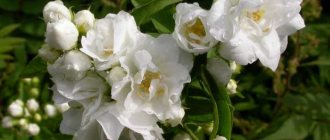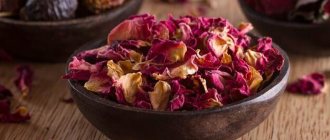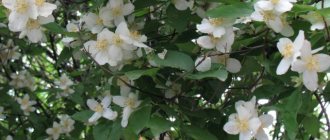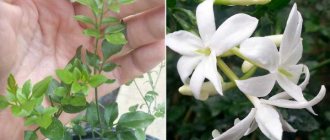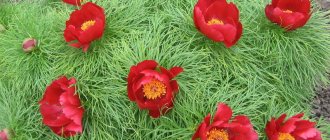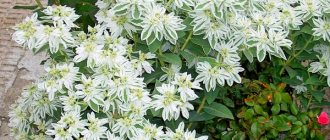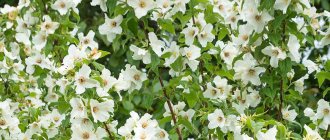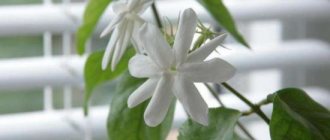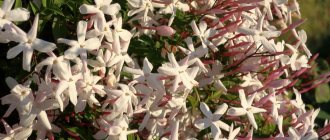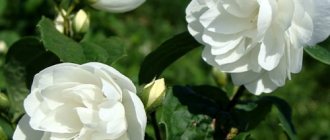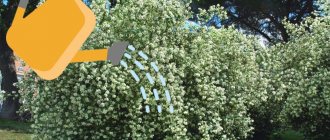General description of culture
The culture includes more than 250 plant species. These can be climbing bushes or plants with straight stems. The shoots are thin, covered with unpaired leaves of rich green color. The inflorescences have the shape of lush umbrellas.
The color of the petals is varied: from cream to yellow. The plant is known for its unpretentiousness and rapid adaptation to changing environmental conditions. The benefits and harms of jasmine flowers are also very interesting, for which the plant has gained particular popularity.
What does mock orange look like?
Chubushnik shneeshturm - description, planting and care
Only a few plant species are cultivated in gardens, differing in a number of characteristics. There are similar characteristics that help determine what jasmine looks like:
- this is a plant with numerous slender trunks;
- it has entire opposite leaves;
- jasmine bush flower of regular shape, light shades.
There is debate among gardeners about whether jasmine is a shrub or a tree. Judging by the number of trunks, the plant can be called bushy. But the wood is dense; mock orange reaches a height of 3-4 meters. Therefore, many people believe that jasmine is a tree.
Among the mock oranges grown in Russia, there are 3 common species, with characteristic differences for each.
Main types of jasmine
| Name | Description |
| Coronary | The plant reaches a height of 3 m, but there are also dwarf forms for the garden. Produces racemose, fragrant inflorescences. Creamy white flowers reach 3.5 cm in diameter. There is also double jasmine with large flowers |
| Large-flowered | Mock orange grows up to 4 m. Snowy white color is formed on the side branches in the form of beautiful large brushes |
| Lemoine | There are dwarf forms and tall ones (up to 3 m in height). Racemose inflorescences are collected from large white densely double flowers more than 4 cm in diameter. There are varieties with inflorescences in the form of loose plumes half a meter long |
Mock orange crown
Note! Jasmine plant is winter-hardy, so it is actively cultivated in the northern regions. But mock orange, growing in the south, gives a more luxuriant color.
How does a plant bloom?
Jasmine is a tall, tree-like shrub. In addition to white or cream flowers, it also blooms light golden ones. Budding occurs in May; already from June the garden is filled with a persistent fragrant fragrance.
Some are surprised how jasmine blooms and when, if its petals are closed during the day. The mock orange inflorescences wake up with the onset of darkness (when the Sun God retires). The aroma exuded by jasmine is so strong that its notes can linger in the garden until midday.
Fragrance time may vary among varieties. For most, flowering lasts until the end of August. Only the coronal mock orange sheds its petals after 20 days, managing to produce abundant color during this time.
The essential jasmine scent is actively used in perfumery to create perfumes, colognes, and deodorants. Flower teas with mock orange petals are popular all over the world due to their tonic properties.
Areas of use
Jasmine flowers contain a huge amount of essential oils that have bactericidal properties. Thanks to their unique composition and persistent pleasant aroma, the inflorescences are used in perfumery, cosmetology, and medicine:
- The active substances in jasmine flowers stimulate the immune system, enhancing the immune response.
- Tea made from jasmine inflorescences enhances gastrointestinal motility, binds toxins and promotes their rapid elimination from the body.
- Flowers are also used locally for contaminated wounds. The antiseptic effect of jasmine blocks the breathing, growth and reproduction of microorganisms.
The stimulating effect is widely used in gynecological practice, for the prevention and treatment of a number of female diseases. Knowledge of the medicinal properties and contraindications for the use of jasmine flowers will allow you to most optimally use the plant for practical purposes.
Collection and drying of inflorescences
Happy owners of garden jasmine should learn how to collect flowers from a bush:
- The inflorescences are collected after full opening. At the same time, the time of collection matters: the gardener needs to catch it before sunrise. When exposed to sunlight, essential oils quickly evaporate from the surface of the leaf.
- The flowers are picked off, being careful not to damage the delicate inflorescences. Evaporation of oils will lead to the complete disappearance of the bactericidal effect.
A number of rules for drying jasmine flowers for tea:
- All twigs and leaves are removed from the collected flowers.
- The inflorescence petals are scattered in a thin layer on paper and left to dry. There should be no thermal effects - only wind and warm weather.
During the drying process, the petals are turned over several times to remove any darkened flowers. Properly dried buds remain exclusively white.
Outdoor care
The jasmine flower is widespread in almost all regions of the country (Arzamas, Moscow, all southern regions, central regions). A great time to plant jasmine is spring. The plant easily tolerates even morning frosts, being particularly unpretentious in care. But it is better to avoid planting in areas with strong drafts and depleted soil.
Applying fertilizers to the soil
Young plants are planted in a pit with mineral and organic fertilizers. The next feeding is carried out only after a year. The active composition of the fertilizer includes water, superphosphate, urea, and potassium. Manure is used only in the form of a solution and rotted mass (fresh manure can cause severe burns to the root system).
Bush pruning
Branches are pruned constantly to form the crown (in spring). Several times it is necessary to carry out anti-aging pruning with the removal of branches without buds. You should not be afraid to remove excess branches, because young shoots will grow very quickly. Throughout the season, the bushes are carefully inspected, and all damaged shoots are removed.
Jasmine propagation
There are several methods for propagating the bush, and this property is associated with the excellent adaptation of the plant crop:
- Growing from seeds is a long and very unpopular method among gardeners.
- Cuttings are the simplest propagation method. At the end of spring or June, the strongest shoot is cut from the bush. Place the shoot in a container with peat, be sure to place it in a bright place and spray it with water every day. Planting a new shoot in open ground is done by transshipment, so as not to damage the root system.
- Strong strong shoots can be tilted to the ground and sprinkled with soil. This method is called propagation by layering. Over the course of three summer months, young roots will grow on the cuttings, and it will be possible to separate the new plant from the mother bush.
Another method is to divide the root. They use this approach only in the fall, and divide as carefully as possible, without unnecessary damage.
Growing Tips
Experienced gardeners share some secrets of growing winter jasmine:
- The root area of the plant should be covered with compost or leaves in winter.
- In order for the bush to branch well, it is recommended to pinch the tops of the shoots, leaving 6–8 pairs of leaves.
- This type is perfect for a hedge, which will look especially impressive in winter.
- If there is severe frost outside, then the bush must be covered with agrofibre or pine branches.
- Jasmine shoots without support will spread along the ground and take root. This can lead to the formation of dense thickets.
Learn how to plant and care for forget-me-not flowers.
Even winter landscapes can be decorated with flowers. To do this, it is enough to plant bare-flowered jasmine on your site or indoors. With its bright yellow flowers, the variety will mentally return everyone who admires it to summer. Moreover, to create a memorable landscape design with the participation of this crop, you do not need to spend a lot of effort - holoflowered jasmine is unpretentious in care and has no special requirements for cultivation.
Caring for indoor jasmine
Such an amazing and beautiful culture can grow on the windowsill of an apartment or private house. The flower pot is placed only on an east or west window so that the plant has a constant stream of sunlight.
In the warm season, the pot is taken out into the fresh air (this can be a balcony or summer terrace). It is important to ensure that there are no drafts or direct sunlight in this area (risk of leaf burns).
Indoor plants must be constantly sprayed to maintain high air humidity. Only settled water at room temperature is used for this purpose. Stop spraying during the period of active flowering of the bush.
Caring for jasmine (indoors or intended for open ground) is not particularly difficult. Even inexperienced gardeners can cope with the tasks. Following a number of simple rules will allow you to admire the snow-white cloud of bright inflorescences throughout the season and even drink very healthy, delicious tea.
Correct disembarkation process
For the best growth of jasmine, it is necessary not only to carefully select the soil, but also to the planting process itself.
The photo shows the step-by-step procedure for planting it correctly:
- And although the shrub can grow successfully in any soil, it is better to choose soil that contains nutrients.
- Since the roots respond negatively to excess moisture, the plot of land that is located on a slight elevation should be chosen.
- Then you need to pour sand mixed with small pebbles into the hole. This layer will act as drainage. In the spring, you can add 40 g of nitrophosphate to the hole so that the plant grows faster.
- After planting the bush and compacting the soil, the plant is watered.
